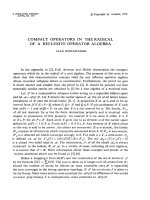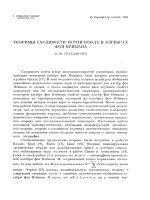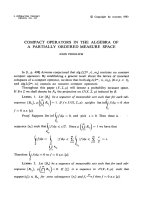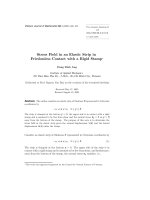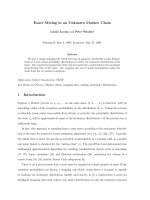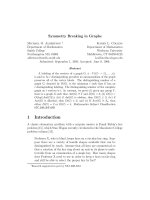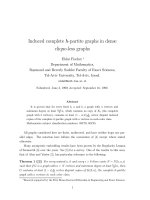Báo cáo toán học: "Heterochromatic matchings in edge-colored graphs" potx
Bạn đang xem bản rút gọn của tài liệu. Xem và tải ngay bản đầy đủ của tài liệu tại đây (124.34 KB, 10 trang )
Heterochromatic matchings in edge-colored graphs
Guanghui Wang
School of Mathematics and System Science
Shandong University, 250100 Jinan, Shandong, P. R.China
Laboratoire de Recherche en Informatique
UMR 8623, C. N. R. S. -Universit´e de Paris-sud, 91405-Orsay Cedex, France
Hao Li
Laboratoire de Recherche en Informatique
UMR 8623, C. N. R. S. -Universit´e de Paris-sud, 91405-Orsay Cedex, France
School of Mathematics and Statistics
Lanzhou University, Lanzhou 730000, China
Submitted: Dec 2, 2007; Accepted: Oct 28, 2008; Published: Nov 14, 2008
Mathematics Subject Classifications: 05C38, 05C15
Abstract
Let G be an (edge-)colored graph. A heterochromatic matching of G is a match-
ing in which no two edges have the same color. For a vertex v, let d
c
(v) be the
color degree of v. We show that if d
c
(v) ≥ k for every vertex v of G, then G has
a heterochromatic matching of size
5k−3
12
. For a colored bipartite graph with bi-
partition (X, Y ), we prove that if it satisfies a Hall-like condition, then it has a
heterochromatic matching of cardinality
|X|
2
, and we show that this bound is best
possible.
1 Introduction and notation
We consider simple undirected graphs. Let G = (V, E) be a graph. An edge coloring of
G is a function C : E → {0, 1, 2, · · · }. If G is assigned such a coloring C, then we say
that G is an edge colored graph, or simply colored graph. Denote by C(e) the color of
the edge e ∈ E. For a subgraph H of G, let C(H) = {C(e) : e ∈ E(H)}.
We study heterochromatic matchings, the case H is a matching. Unlike uncolored
matchings for which the maximum matching problem is solvable in polynomial time (see
[13]), the maximum heterochromatic matching problem is NP-complete, even for bipartite
graphs (see [9]).
the electronic journal of combinatorics 15 (2008), #R138 1
The heterochromatic subgraphs have received increasing attention in the last decade as
mentioned below. Albert, Frieze and Reed [2] proved that the colored complete graph K
n
has a heterochromatic Hamiltonian cycle if n is sufficiently large and no color appears more
than cn times, where c < 1/32. Suzuki [17] gave a sufficient and necessary condition
for the existence of a heterochromatic spanning tree in a colored connected graph. For
more references, see [3, 6, 7, 8, 10].
Theorem 1.1 [16] Every n × n Latin square has a partial transversal of length at least
n − 5.53(log n)
2
, namely every properly edge-colored complete bipartite graph K
n,n
with n
colors has a heterochromatic matching with at least n − 5.53(log n)
2
edges.
For colored complete graphs, Kaneko and Suzuki gave the following result.
Theorem 1.2 [12] For n ≥ 3, each proper edge coloring of K
2n
has a heterochromatic
perfect matching.
Let G be a colored graph. For a vertex set S, a color neighborhood of S is defined as a
set T ⊆ N(S) such that there are |T | edges between S and T that are incident at distinct
vertices of T and have distinct colors. A maximum color neighborhood N
c
(S) is a color
neighborhood of S with maximum size. In particular, if S = {v}, then let d
c
(v) = |N
c
(v)|
and call it the color degree of v. Given a set S and a color neighborhood T of S, denote by
C(S, T ) a set of |T | distinct colors on some such set of |T | edges between S and distinct
vertices of T .
In [15], we obtained the following result concerning heterochromatic matchings in
colored bipartite graphs meeting a color degree condition.
Theorem 1.3 [15] For a colored bipartite graph G, if d
c
(v) ≥ k ≥ 3 for each vertex
v ∈ V (G), then G has a heterochromatic matching of cardinality
2k
3
.
In this paper, we study heterochromatic matchings in general graphs and obtain the
following result.
Theorem 1.4 Let G be a colored graph. If d
c
(v) ≥ k for each vertex v ∈ V (G), then G
has a heterochromatic matching of cardinality
5k−3
12
.
We propose the following strengthening of Theorem 1.4.
Conjecture 1.1 Let G be a colored graph. Suppose that d
c
(v) ≥ k ≥ 4 for each vertex v
of G, then there exists a heterochromatic matching with
k
2
edges.
The complete graph K
k+1
with a proper edge coloring satisfies d
c
(v) = k for each
vertex v, and K
k+1
contains no heterochromatic matching of cardinality more than
k
2
.
Thus if the above conjecture holds, it would be best possible.
In [14], large heterochromatic matchings under some color neighborhood conditions in
colored bipartite graphs were studied and the following result was obtained.
the electronic journal of combinatorics 15 (2008), #R138 2
Theorem 1.5 [14] Let G be a colored bipartite graph with bipartition (X, Y ) and |X| =
|Y | = n. If |N
c
(S)| ≥ |S| for all S ⊆ X or S ⊆ Y , then G has a heterochromatic
matching of cardinality
3n
8
.
In the case of 3-partite 3-uniform hypergraphs, Aharoni [1] verified a conjecture of
Ryser. Using this result, we improve the bound in Theorem 1.5 as follows.
Theorem 1.6 Let G be a colored bipartite graph with bipartition (X, Y ). If |N
c
(S)| ≥ |S|
for all S ⊆ X, then G has a heterochromatic matching of cardinality
|X|
2
.
Moreover, we show that the bound in Theorem 1.6 is sharp.
2 Proof of Theorem 1.4
Before the proof of Theorem 1.4, we give some notations and a proposition. For a hete-
rochromatic matching M of G, let V
M
denote V (M). For a vertex v ∈ V (G − V
M
), let
b
M
(v) denote C(M) ∩ C({vx : x ∈ V (G − V
M
)}). For a subset V
1
of V (G − V
M
), let
b
M
(V
1
) denote {b
M
(v) : v ∈ V
1
}. For simplicity, let b
M
= b
M
(V (G − V
M
)).
Relative a heterochromatic matching M, an alternating 3-path AP
M
in G is a path
x
yxy
such that C(xy
) = C(x
y) /∈ C(M), in which xy ∈ E(M) and x
, y
∈ V (G − V
M
).
Given two alternating 3-paths AP
1
M
= x
1
y
1
x
1
y
1
and AP
2
M
= x
2
y
2
x
2
y
2
, AP
1
M
is different
from AP
2
M
, by the phrase we mean that C(x
1
y
1
) = C(x
2
y
2
) and x
1
y
1
= x
2
y
2
.
Easily, we can get the following proposition by Theorem 1.2.
Proposition 2.1 For m ≥ 5, each proper edge coloring of K
m
has a heterochromatic
matching of cardinality
m−1
2
.
Proof of Theorem 1.4
For k ≤ 3, Theorem 1.4 holds clearly. So we assume that k ≥ 4. Suppose the
conclusion is false, then we choose a heterochromatic matching M such that
(R
1
) |M| = t is maximum;
(R
2
) subject to (R
1
), |b
M
| is maximum.
Let C(M) = {c
1
, c
2
, · · · , c
t
}. Since for each vertex v, d
c
(v) ≥ k ≥ 4 and t ≤
5k−3
12
−1,
it holds that |V (G − V
M
)| ≥ 2. Choose v
x
, v
y
∈ V (G − V
M
). Let N
c
(v
x
), N
c
(v
y
) be
maximum color neighborhoods of v
x
, v
y
, respectively. Let N
c
(v
x
) = S
1
∪ S
2
(S
1
∩ S
2
= ∅),
where C(v
x
, S
1
) ∩ C(M) = ∅ and C(v
x
, S
2
) ⊆ C(M). Further let N
c
(v
y
) = S
3
∪ S
4
(S
3
∩
S
4
= ∅), in which C(v
y
, S
3
) ∩ C(M) = ∅ and C(v
y
, S
4
) ⊆ C(M). Clearly |S
2
|, |S
4
| ≤ t.
Claim 2.1 S
1
, S
3
⊆ V
M
.
Proof. Otherwise, there exists a vertex v ∈ V (G − V
M
) such that C(v
x
v)(or C(v
y
v)) /∈
C(M), then M ∪ {v
x
v}(or {v
y
v}) is a heterochromatic matching of cardinality t + 1, a
contradiction.
the electronic journal of combinatorics 15 (2008), #R138 3
Claim 2.2 There exists an AP
M
in G.
Proof. Since |N
c
(v
x
)| = |S
1
| + |S
2
| ≥ k, it follows that |S
1
| ≥ k − |S
2
| ≥ k − t. Similarly
|S
3
| ≥ k − |S
4
| ≥ k − t. Hence |S
1
| + |S
3
| ≥ 2(k − t) = 2k − 2t > 2t = |V
M
|. Then there
exists an edge xy ∈ M such that x is adjacent with v
y
and y is adjacent with v
x
, moreover
C(xv
y
), C(v
x
y) /∈ C(M). If C(xv
y
) = C(v
x
y), letting M
= M ∪ {xv
y
, v
x
y} − {xy}, we
see that M
is a heterochromatic matching and |M
| = t + 1, a contradiction. Thus
C(xv
y
) = C(v
x
y), and it follows that v
x
yxv
y
is an AP
M
.
Let l be the maximum number of the vertex-disjoint AP
M
s in G satisfying that every
pair of AP
M
s are different. Clearly 1 ≤ l ≤ t. For 1 ≤ i ≤ l, assume that AP
i
M
has edges
{x
i
y
i
, x
i
y
i
, x
i
y
i
}, where x
i
y
i
∈ E(M), x
i
, y
i
∈ V (G − V
M
) and C(x
i
y
i
) = C(x
i
y
i
) = c
i
.
Let V
L
denote {x
1
, x
2
, · · · , x
l
} ∪ {y
1
, y
2
, · · · , y
l
} and let V
M
l
denote {x
1
, x
2
, · · · , x
l
} ∪
{y
1
, y
2
, · · · , y
l
}, where {x
1
y
1
, x
2
y
2
, · · · , x
l
y
l
} = E(M
l
) ⊆ E(M). We abbreviate C
l
=
C(M
l
) = {c
1
, c
2
, · · · , c
l
} and C
L
= {c
1
, c
2
, · · · , c
l
}. Clearly C(M) − C(M
l
) = C(M − M
l
).
Let S
0
= V − V
M
− V
L
, and we have the following claim.
Claim 2.3 |S
0
| ≥ 2.
Proof. Otherwise, we have that |S
0
| ≤ 1. If |S
0
| = 1, then assume that S
0
= {u}. Since
for each vertex v of G, d
c
(v) ≥ k, then 2(t + l) + 1 ≥ k + 1. If 2(t + l) + 1 = k + 1,
then G is a colored complete graph such that |V (G)| = k + 1 and d
c
(v) = k ≥ 4 for each
vertex v of G. That is, G is an proper-edge-colored complete graph of order at least 5.
Thus, by Proposition 2.1, G has a heterochromatic matching of size
k
2
≥
5k−3
12
> t, a
contradiction. So we conclude that 2(t + l) ≥ k + 1, then l ≥
k+1
2
− t. Now consider the
vertices x
1
, y
1
and we have the following facts.
Fact 2.1 Suppose y
1
has a neighbor v ∈ V (M
l
)\{x
1
} and C(vy
1
) /∈ C(M − M
l
), where
without loss of generality, let v = x
i
(2 ≤ i ≤ l). Then
(1) C(x
i
y
1
) = c
i
.
(2) |b
M
(x
i
)| ≥ 1.
(3) C
l
∩ b
M
(x
i
) = ∅.
Proof. Suppose, to the contrary, C(x
i
y
1
) = c
i
, then let
M
=
M ∪ {x
i
y
1
, x
i
y
i
} − {x
i
y
i
} C(x
i
y
1
) /∈ C
l
or C(x
i
y
1
) = c
i
;
M ∪ {x
i
y
1
, x
i
y
i
, x
j
y
j
} − {x
i
y
i
, x
j
y
j
} C(x
i
y
1
) = c
j
, 1 ≤ j ≤ l, j = i.
Then M
is a heterochromatic matching of cardinality t + 1, which is a contradiction.
Thus it holds that C(x
i
y
1
) = c
i
.
If there is an edge e ∈ E(G − V
M
) such that C(e) = c
i
, then e = x
i
y
i
. Otherwise,
assume that e is not incident with x
i
, then M
= M ∪{x
i
y
i
, e}−{x
i
y
i
} is a heterochromatic
matching such that |M
| > t, a contradiction. If |b
M
(x
i
)| = 0, letting M
= M ∪ {x
i
y
i
} −
{x
i
y
i
}, we see that M
is a heterochromatic matching such that |M
| = t and |b
M
| ≥
|b
M
| + |b
M
(x
i
)| ≥ |b
M
| + 1, a contradiction with the choice of M. Thus |b
M
(x
i
)| ≥ 1.
the electronic journal of combinatorics 15 (2008), #R138 4
If C
l
∩ b
M
(x
i
) = ∅, we assume that c
j
∈ b
M
(x
i
), 1 ≤ j ≤ l. There exists an edge
x
i
z ∈ E(G − V
M
) such that C(x
i
z) = c
j
. Then let
M
=
M ∪ {x
i
z, x
i
y
i
} − {x
i
y
i
} j = i, z = y
1
;
M ∪ {x
i
z, x
i
y
1
} − {x
i
y
i
} j = i, z = y
1
;
M ∪ {x
i
z, x
j
y
j
} − {x
j
y
j
} j = i, z = y
j
;
M ∪ {x
i
z, x
j
y
j
} − {x
j
y
j
} j = i, z = y
j
.
Clearly, M
is a heterochromatic matching and |M
| > t, a contradiction.
Similarly to Fact 2.1, we can prove the following fact, for simplicity, we omit the proof.
Fact 2.1
. Suppose x
1
has a neighbor v ∈ V (M
l
)\{y
1
} and C(x
1
v) /∈ C(M − M
l
), where
without loss of generality, let v = y
i
(2 ≤ i ≤ l). Then
(1) C(x
1
y
i
) = c
i
.
(2) |b
M
(y
i
)| ≥ 1.
(3) C
l
∩ b
M
(y
i
) = ∅.
Let N
c
(y
1
) be a maximum color neighborhood of y
1
such that x
1
∈ N
c
(y
1
). Assume
that N
c
(y
1
) = P
1
∪ P
2
(P
1
∩ P
2
= ∅), where C(y
1
, P
1
) ∩ (C(M − M
l
) ∪ {c
1
}) = ∅ and
C(y
1
, P
2
) ⊆ C(M − M
l
) ∪ {c
1
}. Further let P
1
1
= P
1
∩ (V (M
l
)\{y
1
}), |P
1
1
| = p
1
and
P
2
1
= P
1
\P
1
1
. Clearly |P
2
| ≤ t − l + 1.
Let N
c
(x
1
) be a maximum color neighborhood of x
1
such that y
1
∈ N
c
(x
1
). Assume
that N
c
(x
1
) = P
3
∪ P
4
(P
3
∩ P
4
= ∅), where C(x
1
, P
3
) ∩ (C(M − M
l
) ∪ {c
1
}) = ∅ and
C(x
1
, P
4
) ⊆ C(M − M
l
) ∪ {c
1
}. Further let P
1
3
= P
3
∩ (V (M
l
)\{x
1
}), |P
1
3
| = p
3
and
P
2
3
= P
3
\P
1
3
. Clearly |P
4
| ≤ t − l + 1.
By symmetry and without loss of generality, we assume that P
1
1
= {x
k
1
(x
k
1
=
x
1
), x
k
2
· · · , x
k
p
1
} and let P
1
1
denote {x
k
2
, · · · x
k
p
1
}. Similarly we assume that P
1
3
=
{y
j
1
(y
j
1
= y
1
), y
j
2
, · · · , y
j
p
3
} and let P
1
3
denote {y
j
2
, · · · y
j
p
3
}. Firstly, we assume that
P
1
1
, P
1
3
= ∅.
Fact 2.2 |b
M
(P
1
1
)| ≥ p
1
− 1 and |b
M
(P
1
3
)| ≥ p
3
− 1.
Proof. If |b
M
(P
1
1
)| < p
1
−1 then M
= M ∪ {x
k
2
y
k
2
, · · · , x
k
p
1
y
k
p
1
}−{x
k
2
y
k
2
, · · · , x
k
p
1
y
k
p
1
}
is a heterochromatic matching such that |M
| = t and |b
M
| ≥ |b
M
| + p
1
− 1 − |b
M
(P
1
1
)| >
|b
M
|, a contradiction. Thus |b
M
(P
1
1
)| ≥ p
1
− 1. Similarly, we can prove that |b
M
(P
1
3
)| ≥
p
3
− 1.
Without loss of generality, we assume that b
M
(P
1
1
) = {c
l+1
, c
l+2
, · · · , c
l+p
2
}. Let
V (M
p
2
) = {x
l+1
, x
l+2
, · · · , x
l+p
2
} ∪ {y
l+1
, y
l+2
, · · · , y
l+p
2
}. Similarly, we assume that
b
M
(P
1
3
) = {c
i
1
, c
i
2
, · · · , c
i
p
4
}. Let V (M
p
4
) denote {x
i
1
, x
i
2
, · · · , x
i
p
4
} ∪ {y
i
1
, y
i
2
, · · · , y
i
p
4
}.
Fact 2.3 Suppose x
1
and y
1
have a common neighbor v ∈ V (M
p
4
)∪V (M
p
2
), then C(vx
1
) ∈
C(M − M
l
) ∪ {c
1
} or C(vy
1
) ∈ C(M − M
l
) ∪ {c
1
}.
the electronic journal of combinatorics 15 (2008), #R138 5
Proof. By contradiction. Otherwise, C(vx
1
), C(vy
1
) /∈ C(M − M
l
) ∪ {c
1
}. Without loss
of generality, assume that v = x
i
1
∈ V (M
p
4
) and since c
i
1
∈ b
M
(P
1
3
), moreover we can
assume that c
i
1
∈ b
M
(y
j
2
). By the definition of the b
M
(y
j
2
), we conclude that there is an
edge y
j
2
z ∈ E(G − V
M
) such that C(y
j
2
z) = c
i
1
. We distinguish the following cases.
Case 1. z = x
1
. Then let
M
=
M ∪ {x
i
1
y
1
, y
j
2
z} − {x
i
1
y
i
1
} C(x
i
1
y
1
) /∈ C
l
;
M ∪ {x
i
1
y
1
, y
j
2
z, x
j
2
y
j
2
} − {x
i
1
y
i
1
, x
j
2
y
j
2
} C(x
i
1
y
1
) = c
j
2
;
M ∪ {x
i
1
y
1
, x
j
y
j
, y
j
2
z} − {x
i
1
y
i
1
, x
j
y
j
} C(x
i
1
y
1
) = c
j
, 2 ≤ j ≤ l and j = j
2
.
Case 2. z = y
1
. Then let
M
=
M ∪ {x
i
1
x
1
, y
j
2
z} − {x
i
1
y
i
1
} C(x
i
1
x
1
) /∈ C
l
;
M ∪ {x
i
1
x
1
, y
j
2
z, x
j
2
y
j
2
} − {x
i
1
y
i
1
, x
j
2
y
j
2
} C(x
i
1
x
1
) = c
j
2
;
M ∪ {x
i
1
x
1
, x
j
y
j
, y
j
2
z} − {x
i
1
y
i
1
, x
j
y
j
} C(x
i
1
x
1
) = c
j
, 2 ≤ j ≤ l and j = j
2
.
Case 3. z /∈ {x
1
, y
1
}. Then let
M
=
M ∪ {x
i
1
y
1
, y
j
2
z} − {x
i
1
y
i
1
} C(x
i
1
y
1
) /∈ C
l
;
M ∪ {x
i
1
y
1
, y
j
2
z, x
j
2
y
j
2
} − {x
i
1
y
i
1
, x
j
2
y
j
2
} C(x
i
1
y
1
) = c
j
2
;
M ∪ {x
i
1
y
1
, x
j
y
j
, y
j
2
z} − {x
i
1
y
i
1
, x
j
y
j
} C(x
i
1
y
1
) = c
j
, 2 ≤ j ≤ l, j = j
2
, z = y
j
;
M ∪ {x
i
1
y
1
, x
j
y
j
, y
j
2
z} − {x
i
1
y
i
1
, x
j
y
j
} C(x
i
1
y
1
) = c
j
, 2 ≤ j ≤ l, j = j
2
, z = y
j
.
In any case, M
is a heterochromatic matching and |M
| > t, which is a contradiction.
For simplicity, let V
denote V (M − M
l
).
Fact 2.4 P
2
1
⊆ V
∪ {y
1
} and P
2
3
⊆ V
∪ {x
1
}.
Proof. Suppose, to the contrary, there is a vertex z ∈ P
2
1
and z /∈ V (M − M
l
) ∪ {y
1
}.
Since P
2
1
= P
1
\P
1
1
, then z /∈ V (M
l
) and C(y
1
z) /∈ C(M − M
l
) ∪ {c
1
}. We distinguish the
following two cases.
Case 1. z ∈ V (G − V
M
− V
L
). In fact, if V (G − V
M
− V
L
) = ∅, then z = u. Then let
M
=
M ∪ {y
1
z} C(y
1
z) /∈ C
l
;
M ∪ {y
1
z, x
j
y
j
} − {x
j
y
j
} C(y
1
z) = c
j
, 2 ≤ j ≤ l.
Case 2. z ∈ V
L
. Assume that z = x
i
(1 ≤ i ≤ l), then let
M
=
M ∪ {y
1
z} C(y
1
z) /∈ C
l
;
M ∪ {y
1
z, x
j
y
j
} − {x
j
y
j
} C(y
1
z) = c
j
, 2 ≤ j ≤ l.
In both cases, M
is a heterochromatic matching and |M
| > t, which is a contradiction.
Thus it holds that P
2
1
⊆ V
∪ {y
1
}. Similarly, we have that P
2
3
⊆ V
∪ {x
1
}.
By Facts 2.3 and 2.4, we conclude that
|P
2
1
∩ V
| + |P
2
3
∩ V
| ≤ 2|V
| − |M
p
2
| − |M
p
4
|
≤ 4(t − l) − p
2
− p
4
the electronic journal of combinatorics 15 (2008), #R138 6
On the other hand, |P
2
1
∩ V
| ≥ k − |P
2
| − |P
1
1
| − |P
2
1
∩ {y
1
}| ≥ k − (t − l + 1) − p
1
− 1
and |P
2
3
| ≥ k − |P
4
| − |P
1
3
∩ {x
1
}| ≥ k − t + l − p
3
− 2. Since t ≤
5k−3
12
− 1, l ≥
k+1
2
− t
and, by Fact 2.2, p
2
≥ p
1
− 1, p
4
≥ p
3
− 1, it follows that
|P
2
1
∩V
| + |P
2
3
∩ V
| − [4(t − l) − p
2
− p
4
]
≥ 2k − 2t + 2l − p
1
− p
3
− 4 − 4t + 4l + p
1
+ p
3
− 2
≥ 2k − 6t + 6l − 6
≥ 5k − 12t − 3
> 0.
Note that if P
1
1
= ∅ or P
1
3
= ∅, the above two inequalities also hold, which is a contra-
diction.
So we have that |S
0
| ≥ 2, which completes the proof of Claim 2.3.
Now let w
1
, w
2
∈ S
0
. Choose a maximum color neighborhood N
c
(w
1
) of w
1
. Assume
that N
c
(w
1
) = T
1
∪ T
2
(T
1
∩ T
2
= ∅), where C(w
1
, T
1
) ∩ C(M − M
l
) = ∅ and C(w
1
, T
2
) ⊆
C(M −M
l
). Further let T
1
1
= T
1
∩ V (M
l
), |T
1
1
| = t
1
and T
2
1
= T
1
\T
2
1
. Clearly |T
2
| ≤ t − l.
Similarly, choose a maximum color neighborhood N
c
(w
2
) of w
2
. And let N
c
(w
2
) =
T
3
∪ T
4
(T
3
∩ T
4
= ∅), where C(w
2
, T
3
) ∩ C(M − M
l
) = ∅ and C(w
2
, T
4
) ⊆ C(M − M
l
).
Further let T
1
3
= T
3
∩ V (M
l
), |T
1
3
| = t
2
and T
2
3
= T
3
\T
1
3
. Clearly |T
4
| ≤ t − l.
Claim 2.4 Suppose w(w ∈ {w
1
, w
2
}) has a neighbor v ∈ V (M
l
) and C(wv) /∈ C(M −M
l
),
where without loss of generality, let v = x
i
(1 ≤ i ≤ l). Then C(wx
i
) = c
i
.
Proof. Otherwise, if C(wx
i
) /∈ C(M − M
l
) and C(wx
i
) = c
i
. Then let
M
=
M ∪ {wx
i
, x
i
y
i
} − {x
i
y
i
} C(wx
i
) /∈ C
l
or C(wx
i
) = c
i
;
M ∪ {wx
i
, x
i
y
i
, x
j
y
j
} − {x
i
y
i
, x
j
y
j
} C(wx
i
) = c
j
, 1 ≤ j ≤ l, j = i.
Then M
is a heterochromatic matching of cardinality t + 1, which is a contradiction.
Claim 2.5 T
2
1
⊆ V (M − M
l
) and T
2
3
⊆ V (M − M
l
).
Proof. By symmetry, we only prove that T
2
1
⊆ V (M − M
l
). Otherwise, there is an
edge w
1
z such that C(w
1
z) /∈ C(M − M
l
), in which z ∈ T
2
1
and z /∈ V (M − M
l
). Since
T
2
1
= T
1
\T
1
1
, z /∈ V (M
l
). We distinguish the following two cases.
Case 1. z ∈ V (G − V
M
− V
L
). Then let
M
=
M ∪ {w
1
z} C(w
1
z) /∈ C
l
;
M ∪ {w
1
z, x
j
y
j
} − {x
j
y
j
} C(w
1
z) = c
j
, 1 ≤ j ≤ l.
Case 2. z ∈ V
L
. Without loss of generality, assume that z = x
1
, then let
M
=
M ∪ {w
1
z} C(w
1
z) /∈ C
l
;
M ∪ {w
1
z, x
j
y
j
} − {x
j
y
j
} C(w
1
z) = c
j
, 1 ≤ j ≤ l.
the electronic journal of combinatorics 15 (2008), #R138 7
In both cases, M
is a heterochromatic matching and |M
| > t, which is a contradiction.
Since |N
c
(w
1
)| = |T
1
| +|T
2
| ≥ k, it follows that |T
2
1
| ≥ k −|T
2
| −|T
1
1
| ≥ k −(t − l) − t
1
.
Similarly it holds that |T
2
3
| ≥ k − (t − l) − t
2
. Then
|T
2
1
| + |T
2
3
| − |V
| ≥ 2k − 2t + 2l − t
1
− t
2
− 2(t − l)
≥ 2k − 4t + 4l − t
1
− t
2
≥ 2l + 1.
So there exists an edge x
0
y
0
∈ E(M − M
l
), where x
0
∈ T
2
1
, y
0
∈ T
2
3
and C(w
1
x
0
) /∈
C
l
∪ C
L
. Note that C(w
1
x
0
), C(w
2
y
0
) /∈ C(M − M
l
).
If C(w
2
y
0
) ∈ C
l
, suppose C(w
2
y
0
) = c
i
, 1 ≤ i ≤ l. Let M
= M ∪ {w
1
x
0
, w
2
y
0
, x
i
y
i
} −
{x
i
y
i
, x
0
y
0
}, then M
is a heterochromatic matching and |M
| > t, a contradiction.
If C(w
2
y
0
) /∈ C
l
and C(w
2
y
0
) = C(w
1
x
0
), then let M
= M ∪ {w
1
x
0
, w
2
y
0
} − {x
0
y
0
}.
Thus M
is a heterochromatic matching and |M
| > t, a contradiction.
If C(w
2
y
0
) = C(w
1
x
0
), then we obtain an AP
M
= w
2
y
0
x
0
w
1
, where C(w
2
y
0
) =
C(w
1
x
0
) /∈ C(M) ∪ C
L
, x
0
y
0
∈ E(M − M
l
) and w
1
, w
2
∈ V (G − V
M
). So there ex-
ists (l + 1) vertex-disjoint AP
M
s, in which every pair of AP
M
s are different, which is a
contradiction.
The proof of Theorem 1.4 is complete.
3 Proof of Theorem 1.6
Firstly, we give some preliminaries. A hypergraph is a set of subsets, called hyperedges, of
some ground set, whose elements are called vertices. A hypergraph H is called r-uniform
(or an r-graph) if all its hyperedges are of the same size, r. An r-uniform hypergraph
is called r-partite if its vertex set V (H) can be partitioned into sets V
1
, · · · , V
r
in such a
way that each hyperedge meets each V
i
in precisely one vertex.
A matching in a hypergraph is a set of disjoint hyperedges. The matching number,
ν(H), of a hypergraph H is the maximal size of a matching in H.
A cover of a hypergraph H is a subset of V (H) meeting all hyperedges of H. The
covering number, τ(H), of H is the minimal size of a cover of H. Obviously, τ ≥ ν for all
hypergraphs. In a r-uniform hypergraph τ ≤ rν, since the union of the hyperedges of a
maximal matching forms a cover.
Ryser gave a conjecture as follows.
Conjecture 3.1 In a r-partite r-uniform hypergraph (where r > 1), τ ≤ (r − 1)ν.
This conjecture appeared in the Ph.D thesis of Henderson, a student of Ryser. For
small values of r, only the case r = 3 was studied for general ν. The bounds for this case
were improved successively: τ ≤
25
9
ν [11], τ ≤
8
3
ν [18], τ ≤
5
2
ν [19]. Finally, it was proved
by Aharoni [1].
the electronic journal of combinatorics 15 (2008), #R138 8
Theorem 3.1 [1] In a tripartite 3-graph, τ ≤ 2ν.
Proof of Theorem 1.6
Construct a 3-partite 3-uniform hypergraph H as follows. Let V
1
= X, V
2
= Y and
V
3
= C(G). A hyperedge e = {x, y, c} ∈ E(H) if and only if in graph G, x ∈ X, y ∈ Y
and C(xy) = c. Clearly, a matching of a hypergraph H is a heterochromatic matching of
G. Let M be a maximum heterochromatic matching. Then |M| = ν(H).
We conclude that τ(H) ≥ |X|. Otherwise, assume that D = D
1
∪ D
2
∪ D
3
is a
cover of H with |D| ≤ |X| − 1, in which D
1
∈ V
1
, D
2
∈ V
2
and D
3
∈ V
3
. Now consider
F = X\D
1
in graph G, then there exists a maximum color neighborhood N
c
(F ) such
that |N
c
(F )| ≥ |F | = |X| − |D
1
|. Thus in the hypergraph H, there exists a hyperedge set
E
1
with |E
1
| ≥ |F | such that
(i) for each hyperedge e = {x, y, c} ∈ E
1
, it holds that x ∈ F ;
(ii) for two hyperedges e = {x, y, c}, e
= {x
, y
, c
}, it holds that y = y
and c = c
.
By (i), D
1
does not meet any hyperedge of E
1
. And D = D
1
∪ D
2
∪ D
3
is a cover
of H, so D
2
∪ D
3
meets each hyperedge of E
1
. Thus by (ii) and since D
2
∩ D
3
= ∅, we
conclude that |D
2
| + |D
3
| ≥ |E
1
| ≥ |F | = |X| − |D
1
|. Therefore, |D
1
| + |D
2
| + |D
3
| ≥ |X|,
a contradiction. So τ (H) ≥ |X| and by Theorem 3.1, |X| = τ(H) ≤ 2ν(H) = 2|M|. That
is |M| ≥
|X|
2
, which completes the proof.
Let G = sC
4
, a graph with s components, each a C
4
. Let C be a proper edge coloring
of G with 2s colors so that each color appears exactly twice, both times in the same
C
4
. Any bipartition (X, Y ) for G meets the condition in Theorem 1.6. Yet the largest
heterochromatic matching has cardinality s =
|X|
2
. Thus this example shows that the
bound in Theorem 1.6 is best possible.
Acknowledgements
The authors are indebted to Ron Aharoni for his helpful discussion. We deeply thank the
referee for the constructive comments. This research is supported by the National Natural
Science Foundation (10871119) of China, the French-Chinese foundation for sciences and
their applications and the China Scholarship Council.
References
[1] R. Aharoni, Ryser’s conjecture for tri-partite 3-graphs, Combinatorica. 21(1), 2001,
1-4.
[2] M. Albert, A. Frieze and B. Reed, Multicolored Hamilton cycles, Electronic J. Com-
bin. 2(1995), Research Paper R10.
[3] N. Alon, T. Jiang, Z. Miller and D. Pritikin, Properly colored subgraphs and rainbow
subgraphs in edge-colored graphs with local constraints, Random Struct. Algorithms
23(2003), No. 4, 409-433.
the electronic journal of combinatorics 15 (2008), #R138 9
[4] J.A. Bondy and U.S.R. Murty. Graph Theory with Applications, Macmillan Press[M].
New York, 1976.
[5] H.J. Broersma, X.L. Li, G. Woegingerr and S. Zhang, Paths and cycles in colored
graphs, Australian J. Combin. 31(2005), 297-309.
[6] H. Chen and X.L. Li, Long heterochromatic paths in edge-colored graphs, Electronic
J. Combin. 12(1)(2005), Research Paper R33.
[7] P. Erd˝os and Zs. Tuza, Rainbow subgraphs in edge-colorings of complete graphs,
Ann. Discrete Math. 55(1993), 81-83.
[8] A.M. Frieze and B.A. Reed, Polychromatic Hamilton cycles, Discrete Math. 118
(1993), 69-74.
[9] M.R. Garey and D.S. Johnson, Comuters and Intractability, Freeman, New York,
1979, Pages 203. GT55: Multiple Choice Matching Problem.
[10] G. Hahn and C. Thomassen, Path and cycle sub-Ramsey numbers and edge-coloring
conjecture, Discrete Math. 62(1)(1986), 29-33.
[11] P.E. Haxell, A note on a conjecture of Ryser, Periodica Mathemathikai Lapok
30(1995), 73-79.
[12] M. Kano, Some Results and Problems on Colored Graphs, Lecture in Nankai Uni-
versity, Nov 25, 2006.
[13] E.L. Lawler, Combinatorial Optimization: Networks and Matroids, Holt, Rinehart
and Winston, New York, 1976.
[14] H. Li, X.L. Li, G.Z. Liu, and G.H. Wang, The heterochromatic matchings in edge-
colored bipartite graphs, to appear in Ars Combinatoria, 2006.
[15] H. Li and G.H. Wang, Color degree and heterochromatic matchings in edge-colored
bipartite graphs, Utilitas Math, to appear.
[16] P.W. Shor, A lower bound for the length of a partial transversal in a latin square, J.
Combin. Theory Ser. A 33(1982), 1-8.
[17] K. Suzuki, A Necessary and Sufficient Condition for the Existence of a Heterochro-
matic Spanning Tree in a Graph. Graph and Combin, (22),261-269, 2006
[18] E. Szemeredi and Zs. Tuza, Upper bound for transversals of tripartite hypergraphs,
Period. Math. Hung, 13(1982), 321-323.
[19] Zs. Tuza, On the order of vertex sets meeting all edges of a 3-partite hypergraph,
Ars Combin, 24(1987), A, 59-63.
the electronic journal of combinatorics 15 (2008), #R138 10
